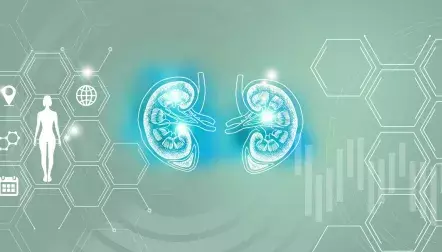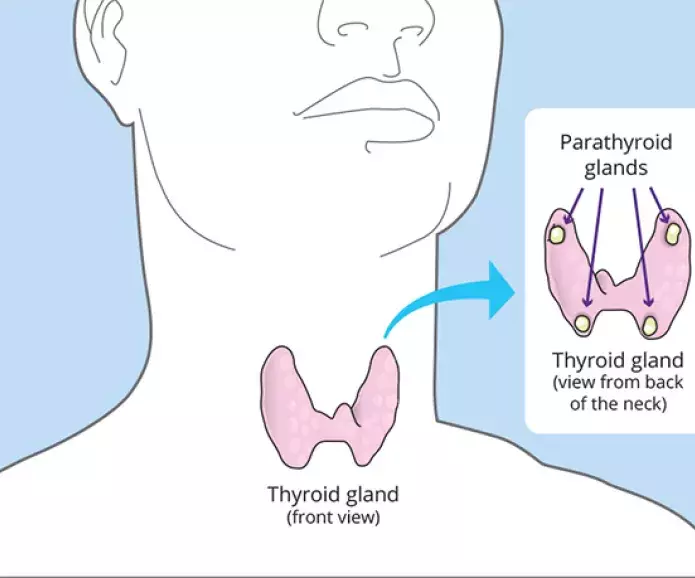
Secondary hyperparathyroidism: symptoms, causes & treatment

- Medically reviewed by
- AKF's Medical Advisory Committee
- Last updated
- June 6, 2024
Secondary hyperparathyroidism is common in people who have kidney failure (stage 5 kidney disease). It happens when your body's levels of calcium, vitamin D and phosphorus are not in balance. It is important to treat secondary hyperparathyroidism to prevent it from causing other health problems, such as bone disease.

What is hyperparathyroidism?
Hyperparathyroidism is a disease that causes your parathyroid glands to make too much parathyroid hormone (PTH). The parathyroid glands are 4 small glands in your neck that make PTH. They are called ‘parathyroid’ because they are next to your thyroid gland.
This image shows where the parathyroid glands are located:
What is parathyroid hormone (PTH)?
PTH controls how much calcium is in your blood and bones. Your body's levels of calcium, vitamin D and phosphorus all need to be in balance. If they are out of balance (meaning one is higher or lower), your parathyroid glands make more PTH to try to "fix" the balance. For example:
- If phosphorus levels in your blood are too high, calcium levels are lower – they are not in balance.
- To fix the balance, your parathyroid glands make more PTH.
- More PTH pulls calcium from your bones to raise the level of calcium in your blood.
There are 3 types of hyperparathyroidism:
- Primary: One or more of your parathyroid glands are larger than normal, which causes them to make too much PTH. This is the most common type of hyperparathyroidism.
- Secondary: This is most common in people with kidney failure.
- Tertiary: This can happen in people after they get a kidney transplant.

Download
Secondary hyperparathyroidism and how to prevent it
Download our guide on secondary hyperparathyroidism (SHPT) to learn how it affects each stage of chronic kidney disease (CKD) and how to prevent it.
What is secondary hyperparathyroidism (SHPT)?
Secondary hyperparathyroidism (SHPT) is a type of hyperparathyroidism. SHPT happens when a disease you have causes low blood calcium, which makes your parathyroid glands grow larger and make too much parathyroid hormone (PTH).
What causes SHPT?
SHPT happens when another disease you have causes low levels of calcium in your blood. The most common cause of SHPT is end-stage renal disease (ESRD), also known as kidney failure.
How kidney failure and low vitamin D cause SHPT
Healthy kidneys change inactive vitamin D to active vitamin D. Your body uses active vitamin D to absorb calcium from the foods you eat to keep balance between calcium and phosphorus.
As your kidneys fail, they are no longer able to change inactive vitamin D to active vitamin D. This creates low levels of vitamin D in your body. When you have low levels of vitamin D, your body absorbs less calcium, and the level of calcium in your blood becomes low. This signals your parathyroid glands to make more PTH and grow larger, which causes SHPT. Your doctor may also call this "renal secondary hyperparathyroidism".
Your PTH level usually starts to go up after 6-12 months of having an eGFR (estimated glomerular filtration rate) that is less than 15 (stage 5 kidney disease). Sometimes, you may be on dialysis for years before you get SHPT.
What are the symptoms of SHPT?
Symptoms of SHPT include:
- Weak or broken bones (osteoporosis)
- Bone and joint pain
- Kidney stones
- Urinating (peeing) more often than normal
- Belly pain
- Feeling weak or tired easily
- Feeling sick to your stomach or throwing up
- Feeling less hungry than usual (loss of appetite)
How will I know if I have SHPT?
If you have kidney failure or any of the symptoms above, talk to your doctor. If they think you may have SHPT, they can find out using these tests:
- Blood tests to measure levels of calcium, vitamin D, parathyroid hormone and to see how well your kidneys are working
- Urine tests to see how much calcium is in your urine and how well your kidneys are working
- X-rays to see if you have kidney stones or broken bones
- Ultrasounds to make images of your kidneys or parathyroid glands, such as to see if your parathyroid glands have grown larger
- Bone density scan to see how strong your bones are
How is SHPT treated?
The main treatments to manage SHPT are to:
- Treat the other disease that caused it – for example, if SHPT is caused by kidney failure, then doctors treat kidney failure with dialysis or a kidney transplant
- Take medicines, including:
- Vitamin D or calcium supplements to help your body absorb calcium
- Calcimimetics, which tell your parathyroid glands to make less PTH
- Have surgery to remove one or more of your parathyroid glands – however, surgery does not treat the disease that caused SHPT, so there is a high chance that SHPT will come back
If you have SHPT, talk with your doctor about ways to treat it to lower your chances of having other serious health problems. If your doctor recommends you limit or raise your intake of certain nutrients, a renal dietitian can help you create a kidney-friendly meal plan that is right for you.
What will happen if SHPT is left untreated?
If left untreated, SHPT can cause other health problems, such as:
- A buildup of calcium under your skin, which can cause painful, open skin sores and infections
- A buildup of calcium in other parts of your body, such as your blood vessels and heart, which can lead to heart attack or stroke
- Bone disease

